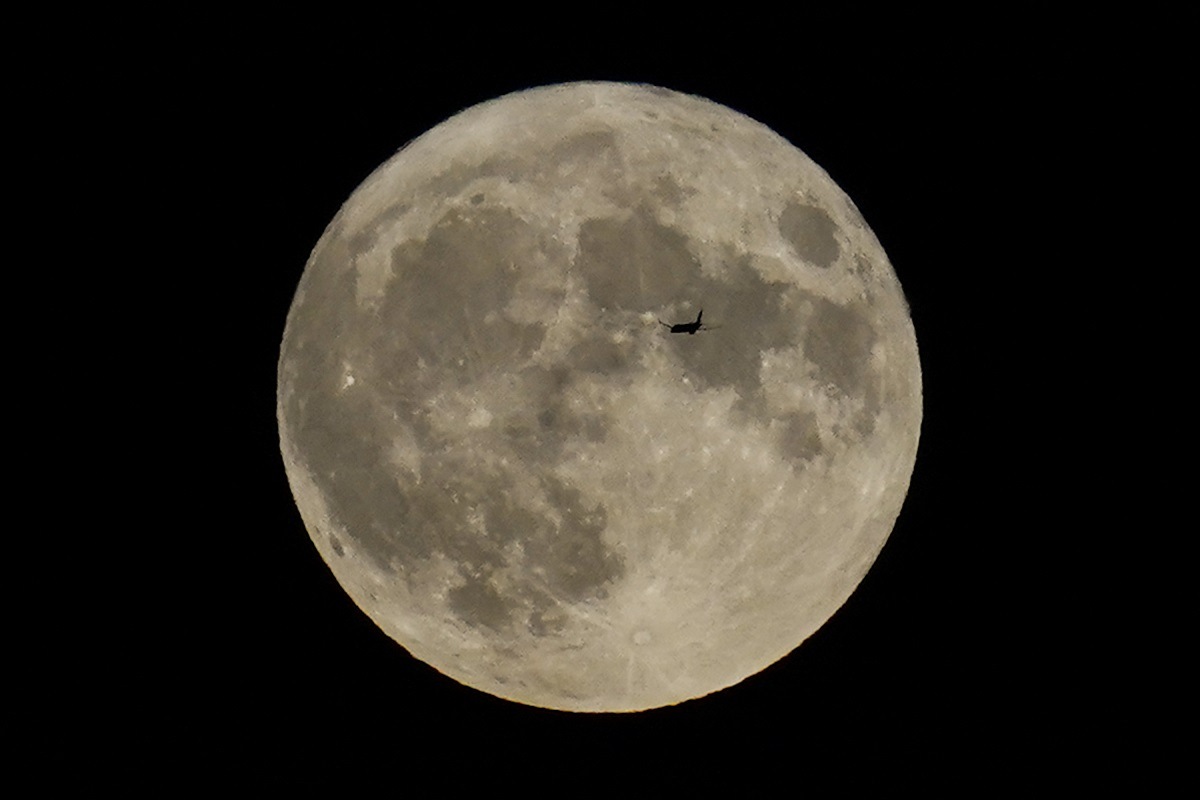Scientists Have Confirmed a Cave on the Moon that Could be Used to Shelter Future Explorers

A plane passes in front of the moon, Aug. 30, 2023, in Chicago.
11:10 JST, July 16, 2024
CAPE CANAVERAL, Fla. (AP) — Scientists have confirmed a cave on the moon, not far from where Neil Armstrong and Buzz Aldrin landed 55 years ago, and suspect there are hundreds more that could house future astronauts.
An Italian-led team reported Monday that there’s evidence for a sizable cave accessible from the deepest known pit on the moon. It’s located at the Sea of Tranquility, just 250 miles (400 kilometers) from Apollo 11’s landing site.
The pit, like the more than 200 others discovered up there, was created by the collapse of a lava tube.
Researchers analyzed radar measurements by NASA’s Lunar Reconnaissance Orbiter, and compared the results with lava tubes on Earth. Their findings appeared in the journal Nature Astronomy.
The radar data reveals only the initial part of the underground cavity, according to the scientists. They estimate it’s at least 130 feet (40 meters) wide and tens of yards (meters) long, probably more.
“Lunar caves have remained a mystery for over 50 years. So it was exciting to be able to finally prove the existence” of one, Leonardo Carrer and Lorenzo Bruzzone of the University of Trento, wrote in an email.
Most of the pits seem to be located in the moon’s ancient lava plains, according to the scientists. There also could be some at the moon’s south pole, the planned location of NASA’s astronaut landings later this decade. Permanently shadowed craters there are believed to hold frozen water that could provide drinking water and rocket fuel.
During NASA’s Apollo program, 12 astronauts landed on the moon, beginning with Armstrong and Aldrin on July 20, 1969.
The findings suggest there could be hundreds of pits on the moon and thousands of lava tubes. Such places could serve as a natural shelter for astronauts, protecting them from cosmic rays and solar radiation as well as from micrometeorite strikes. Building habitats from scratch would be more time-consuming and challenging, even when factoring in the potential need of reinforcing the cave walls to prevent a collapse, the team said.
Rocks and other material inside these caves — unaltered by the harsh surface conditions over the eons — also can help scientists better understand how the moon evolved, especially involving its volcanic activity
"News Services" POPULAR ARTICLE
-

American Playwright Jeremy O. Harris Arrested in Japan on Alleged Drug Smuggling
-

Japan’s Nikkei Stock Average as JGB Yields, Yen Rise on Rate-Hike Bets
-

Japan’s Nikkei Stock Average Licks Wounds after Selloff Sparked by BOJ Hike Bets (UPDATE 1)
-

Japan’s Nikkei Stock Average Buoyed by Stable Yen; SoftBank’s Slide Caps Gains (UPDATE 1)
-

Japanese Bond Yields Zoom, Stocks Slide as Rate Hike Looms
JN ACCESS RANKING
-

Tokyo Economic Security Forum to Hold Inaugural Meeting Amid Tense Global Environment
-

Keidanren Chairman Yoshinobu Tsutsui Visits Kashiwazaki-Kariwa Nuclear Power Plant; Inspects New Emergency Safety System
-

Imports of Rare Earths from China Facing Delays, May Be Caused by Deterioration of Japan-China Relations
-

University of Tokyo Professor Discusses Japanese Economic Security in Interview Ahead of Forum
-

Japan Pulls out of Vietnam Nuclear Project, Complicating Hanoi’s Power Plans

























